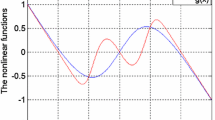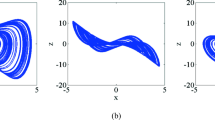Abstract
In this contribution, a novel Jerk system with a smooth piecewise quadratic nonlinearity is introduced. The new nonlinearity provides a similar smoothness as the cubic polynomial function, but a faster response and a simpler circuitry. The basic dynamical properties of the model are discussed in terms of its parameters by using standard nonlinear analysis tools including phase space trajectory plots, frequency spectra, bifurcation diagrams and Lyapunov exponent plots. The bifurcation analysis yields very rich and interesting scenarios such as period-doubling bifurcations, antimonotonicity (i.e. the concurrent creation and annihilation of periodic orbits), periodic windows, and symmetry recovering crises. One of the main findings of this work is the presence of a window in the parameter space in which the novel jerk system experiences the unusual and striking feature of multiple coexisting attractors (i.e. coexistence of four or six disconnected periodic and chaotic attractors) for the same parameters’ setting. Correspondingly, basins of attraction of various competing attractors display extremely complex basin boundaries. Compared to some lower dimensional systems (e.g. Leipnik–Newton system, modified Sprott B system) capable of displaying such type of behavior reported to date, the jerk system introduced in this work represents the simplest and the most ‘elegant’ paradigm. An electronic circuit for allowing an illustration of the theoretical model is proposed and implemented in PSpice. The results obtained in this work let us conjecture that there exist some regions in its parameter space (that need to be uncovered) in which the universal Chua’s circuit experiences six disconnected non static attractors similar to those presented in this work.

















Similar content being viewed by others
References
Masoller C (1994) Coexistence of attractors in a laser diode with optical feedback from a large external cavity. Phys Rev A 50:2569–2578
Cushing JM, Henson SM, Blackburn (2007) Multiple mixed attractors in a competition model. J Biol Dyn 1:347–362
Upadhyay RK (2003) Multiple attractors and crisis route to chaos in a model of food-chain. Chaos Solitons Fractals 16:737–747
Massoudi A, Mahjani MG, Jafarian M (2010) Multiple attractors in Koper–Gaspard model of electrochemical. J Electroanal Chem 647:74–86
Li C, Sprott JC (2014) Coexisting hidden attractors in a 4-D simplified Lorenz system. Int J Bifurc Chaos 24:1450034
Leipnik RB, Newton TA (1981) Double strange attractors in rigid body motion with linear feedback control. Phys Lett A 86:63–87
Guan ZH, Lai Q, Chi M, Chen XM, Liu F (2014) A new three-dimensional system with multiple chaotic attractors. Nonlinear Dyn 75:331–343
Lai Q, Chen S (2016) Generating multiple chaotic attractors from sprott B system. Int J Bifurc Chaos 26(11):1650177
Lai Q, Chen S (2016) Coexisting attractors generated from a new 4D smooth chaotic system. Int J Control Automation Syst 14(4):1124–1131
Kengne J, Njitacke ZT, Fotsin HB (2016) Dynamical analysis of a simple autonomous jerk system with multiple attractors. Nonlinear Dyn 83:751–765
Vaithianathan V, Veijun J (1999) Coexistence of four different attractors in a fundamental power system model. IEEE Trans Circuits Syst I 46:405–409
Kengne J (2015) Coexistence of chaos with hyperchaos, period-3 doubling bifurcation, and transient chaos in the hyperchaotic oscillator with gyrators. Int J Bifurc Chaos 25(4):1550052
Pivka L, Wu CW, Huang A (1994) Chua’s oscillator: a compendium of chaotic phenomena. J Frankl Inst 331B(6):705–741
Kuznetsov AP, Kuznetsov SP, Mosekilde E, Stankevich NV (2015) Co-existing hidden attractors in a radio-physical oscillator. J Phys A Math Theor 48:125101
Kengne J, Njitacke ZT, Nguomkam Negou A, Fouodji Tsotsop M, Fotsin HB (2015) Coexistence of multiple attractors and crisis route to chaos in a novel chaotic jerk circuit. Int J Bifurc Chaos 25(4):1550052
Njitacke ZT, kengne J, Fotsin HB, Nguomkam Negou A, Tchiotsop D (2016) Coexistence of multiple attractors and crisis route to chaos in a novel memristive diode bidge-based Jerk circuit. Chaos Solitons Fractals 91:180–197
Kengne J (2016) On the dynamics of chua’s oscillator with a smooth cubic nonlinearity: occurrence of multiple attractors. Nonlinear Dyn 87(1):363–375
Bao B, Jiang T, Xu Q, Chen M, Wu H, Hu Y (2016) Coexisting infinitely many attractors in active band-pass filter-based memristive circuit. Nonlinear Dyn 86(3):1711–1723
Maggio GM, De Feo O, Kennedy MP (1999) Nonlinear analysis of the Colpitts oscillator and application to design. IEEE Trans Circuits Syst I Fundam Theory Appl 46:1118–1130
Li C, Hu W, Sprott JC, Wang X (2015) Multistability in symmetric chaotic systems. Eur Phys J Spec Top 224:1493–1506
Xu Q, Lin Y, Bao’ B, Chen M (2016) Multiple attractors in a non-ideal active voltage-controlled memristor based Chua’s circuit. Chaos Solitons Fractals 83:186–200
Tang KS, Man KF (1998) An alternative Chua’s circuit implementation. In: Proceedings of the IEEE international symposium on industrial electronics (ISIE ’98), pp 441–444
Tang KS, Man KF, Zhong GQ, Chen G (2001) Generating chaos via \(x|x|\). IEEE Trans Circuits Syst I Fundam Theory Appl 48(5):636–641
Munmuangsaen B, Srisuchinwong B, Sprott JC (2011) Generalization of the simplest autonomous chaotic system. Phys Lett A 375:1445–1450
Sprott JC (2010) Elegant chaos: algebraically simple flow. World Scientific Publishing, Singapore
Sprott JC (2000) Simple chaotic systems and circuits. Am J Phys 68:758–763
Sprott JC (1997) Simplest dissipative chaotic flow. Phys Lett A 228:271–274
Sprott JC (1997) Some simple Jerk functions. Am J Phys 65:537–543
Sprott JC (2011) A new chaotic jerk circuit. IEEE Trans Circuits Syst II Express Br 58:240–243
Eichhorn R, Linz SJ, Hanggi P (2002) Simple polynomial classes of chaotic jerky dynamics. Chaos Solitons Fractals 13:1–15
Strogatz SH (1994) Nonlinear dynamics and chaos. Addison-Wesley, Reading
Nayfeh AH, Balachandran B (1995) Applied nonlinear dynamics: analytical, computational and experimental methods. Wiley, New York
Kuznetsov YA (1995) Elements of applied bifurcation theory. Springer, New York
Li C, Sprott JC (2013) Amplitude control approach for chaotic signals. Nonlinear Dyn 73:1335–1341
Kuznetsov N, Leonov G, Vagaitsev V (2010) Analytical-numerical method for attractor localization of generalized Chua’s system. IFAC Proc Vol 4(1):29–33
Leonov G, Kuznetsov N, Vagaitsev V (2011) Localization of hidden Chua’s attractors Phys. Lett A 375(23):2230–2233
Leonov G, Kuznetsov N, Vagaitsev V (2012) Hidden attractor in smooth Chua systems. Phys D Nonlinear Phenom 241(18):1482–1486
Leonov GA, Kuznetsov NV (2013) Hidden attractors in dynamical systems. From hidden oscillations in Hilbert–Kolmogorov, Aizerman, and Kalman problems to hidden chaotic attractor in Chua circuits. Int J Bifurc Chaos 23(01):1330002
Leonov GA, Kuznetsov NV, Mokaev TN (2015) Homoclinic orbits, and self-excited and hidden attractors in a Lorenz-like system describing convective fluid motion. Eur Phys J Spec Top 224:1421–1458
Wolf A, Swift JB, Swinney HL, Wastano JA (1985) Determining Lyapunov exponents from time series. Phys D 16:285–317
Pisarchik AN, Feudel U (2014) Control of multistability. Phys Rep 540(4):167–218
Dawson SP, Grebogi C, Yorke JA, Kan I, Koçak H (1992) Antimonotonicity: inevitable reversals of period-doubling cascades. Phys Lett A 162:249–254
Parlitz U, Lauterborn W (1985) Superstructure in the bifurcation set of the Duffing equation \(\ddot{x}+ d\dot{x}+ x+ x^{3}= \text{ f } \text{ cos } (\omega \text{ t })\). Phys Lett A 107:351–355
Parlitz U, Lauterborn W (1987) Period-doubling cascades and devil’s staircases of the driven van der Pol oscillator. Phys Rev A 36:1428
Kocarev L, Halle K, Eckert K, Chua L (1993) Experimental observation of antimonotonicity in Chua’s circuit. Int J Bifurc Chaos 3:1051–1055
Ogawa T (1988) Quasiperiodic instability and chaos in the bad-cavity laser with modulated inversion: numerical analysis of a Toda oscillator system. Phys Rev A 37:4286
Kyprianidis I, Stouboulos I, Haralabidis P, Bountis T (2000) Antimonotonicity and chaotic dynamics in a fourth-order autonomous nonlinear electric circuit. Int J Bifurc Chaos 10:1903–1915
Manimehan I, Philominathan P (2012) Composite dynamical behaviors in a simple series-parallel LC circuit. Chaos Solitons Fractals 45:1501–1509
Bier M, Bountis TC (1984) Remerging Feigenbaum trees in dynamical systems. Phys Lett A 104:239–244
Yujun N, Xingyuan W, Mingjun W, Huaguang Z (2010) A new hyperchaotic system and its circuit implementation. Commun Nonlinear Sci Numer Simul 15:3518–3524
Jafari A, Mliki E, Akgul A, Pham VT, Kingni ST, Wang X, Jafari S (2017) Chameleon: the most hidden chaotic flow. Nonlinear Dyn. doi:10.1007/s11071-017-3378-4
Kingni ST, Nana B, Mbouna Ngueuteu GS, Woafo P, Danckaert J (2015) Bursting oscillations in a 3D system with asymmetrically distributed equilibria: mechanism, electronic implementation and fractional derivation effect. Chaos Solitons Fractals 71:29–40
Pham VT, Volos C, Jafari S, Sundarapandian V, Kapitaniak T, Wang X (2016) A chaotic system with different families of hidden attractors. Int J Bifurc Chaos 26(8):1650139
Elsonbaty AR, El-Sayed AMA (2016) Further nonlinear dynamical analysis of simple jerk system with multiple attractors. Nonlinear Dyn 87(2):1169–1186
Hamil DC (1991) Learning about chaotic circuits with SPICE. IEEE Trans Ed 36(1):28–35
Kengne J, Njitacke Tabekoueng Z, Fotsin HB (2016) Coexistence of multiple attractors and crisis route to chaos in autonomous third order Duffing–Holmes type chaotic oscillators. Commun Nonlinear Sci Numer Simul 36:29–44
Bianchi G, Kuznetsov NV, Leonov GA, Seledzhi SM, Yuldashev MV, Yuldashev RV (2016) Hidden oscillations in SPICE simulation of two-phase Costas loop with non-linear VCO. IFAC Pap OnLine 49(14):45–50
Kamdoum Tamba V, Fotsin HB, Kengne J, Megam Ngouonkadi EB, Talla PK (2016) Emergence of complex dynamical behaviors in improved Colpitts oscillators: antimonotonicity, coexisting attractors, and metastable chaos. Int J Dyn Control. doi:10.1007/s40435-016-0223-4
Author information
Authors and Affiliations
Corresponding author
Electronic supplementary material
Below is the link to the electronic supplementary material.
Rights and permissions
About this article
Cite this article
Kengne, J., Signing, V.R.F., Chedjou, J.C. et al. Nonlinear behavior of a novel chaotic jerk system: antimonotonicity, crises, and multiple coexisting attractors. Int. J. Dynam. Control 6, 468–485 (2018). https://doi.org/10.1007/s40435-017-0318-6
Received:
Revised:
Accepted:
Published:
Issue Date:
DOI: https://doi.org/10.1007/s40435-017-0318-6




